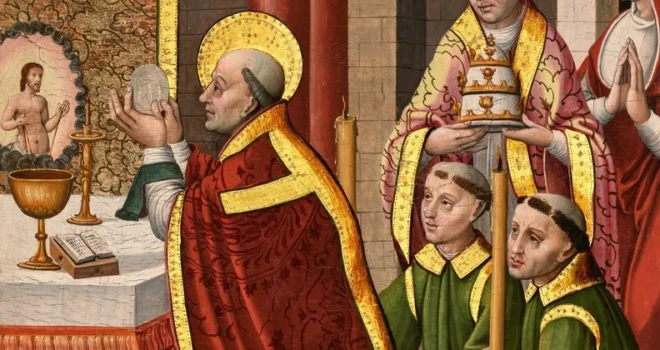Note: If joining “Saintly Influencers” for the first time today, please read the footnote[1], explaining its context, purpose, and aim.
After the fall of Rome in A.D. 476, a cultural and moral malaise descended upon the once-grandiose empire, especially in its western half. Communities of peoples from northern Africa to the British Isles existed largely in a state of isolation from one another. The Eternal City itself was abandoned, except for vagrants and Christian leadership. Within two centuries, Islam arose in the eastern portion of the empire, a new religious influence which necessitated a Christian response. This period, often called “the Dark Ages,” needed the light of Jesus and the Christian Faith. Four saintly influencers brought the communal structure and reforms, along with devotions that the world needed to face these challenges.
Our first saintly influence arose to meet this malaise in the early-sixth century. As a teenager, Benedict left his hometown of Nursia for education in the liberal arts at Rome. Benedict’s first biographer, St. Gregory the Great, shared that the young man soon left Rome so he would not “fall, body and soul, into the bottomless abyss.” He withdrew to the nearby mountains in search of “the habit of a holy way of life” (1998, p. 165). He found a cave in which he dwelt for three years. As word about the young man’s venture spread, others began coming to him, seeking the same solace. This led to the establishment of a monastery for the sake of men seeking to lead virtuous lives in community. When monks sought out Benedict as their abbot, he constructed a regula, a rule for the life of the monastery that laid out a path to holiness for those living in community. The Rule prescribed the cultivation of personal silent reflection, frequent prayerful reading, specific periods of manual labor each day for each monk, and it directed that guests be welcomed as Jesus Himself.[*]
From this first monastery, a network of monasteries spread throughout Europe in the next three centuries. As each monastery became stable, it served as the locus for revitalized social and economic functions within surrounding villages. The life and work of the monks, and the guests they served, necessitated the development of markets and buildings around the monasteries. People were drawn to those central locations for the exchange of goods and services. Thus, we see the beginnings of European cities based on economic specialization, with the monastery at the center.
The second great influencer is St. Gregory the Great, who wore the Benedictine habit and who wrote the first biography of the holy founder mentioned above. Gregory left a career in public service to become a hermit but, near the end of the sixth century, was eventually was elected pope by popular acclamation of the people and clergy of Rome. During his papal service, one of his primary emphases was the reform of the episcopacy. In his Pastoral Rule, Gregory laid the foundation for what Christians in the Middle Ages expected from their bishops. Even into our present age, our expectation about the attitudes, diligence, and moral rectitude of bishops relies on the reform and renewal implemented by Gregory.
The second, more recognizable reason for St. Gregory’s inclusion on this list is his contribution to the Church’s liturgy and prayer. His name is ascribed to the form of music most closely associated with the Catholic Faith and her worship. Gregorian chant has accompanied liturgical prayer and worship for well more than a millennium. Even Vatican Council II calls for its retention within liturgical celebrations. Anyone who has experienced it realizes Gregorian chant well-presented leads the faithful toward the lofty heights of contemplation.
St. Gregory’s influence continues because he is indirectly responsible for the next influencer, St. Bede the Venerable. As pope, Gregory sent a Benedictine monk named Augustine (not Augustine of Hippo, whose influence was highlighted in the previous essay) to share the Gospel with the British Isles. Augustine of Canterbury would begin the evangelization of the Anglo-Saxon peoples, and St. Bede would tell that story more than a century later.
St. Bede the Venerable was the first of the English historians, and his work deeply influenced the remainder of western history. In the Preface to his Ecclesiastical History of the English Nation, he wrote that he intended to “become acquainted with the actions and sayings of former men of renown, especially of our own nation.” Throughout the text, he told stories and created a narrative and perception that solidified the faith of the people who paid fealty to the kings of the Britons. In short, he aided in the development of a national cultural tradition, a way of life among a particular people that would be handed on from generation to generation. We in America have inherited this understanding of a national identity and, more specifically, a national Christian identity, from Venerable Bede.
St. Bede bore another influence that might be even more pervasive. It is to him that we attribute the widespread use of the term Anno Domini when referring to dates. While the dating system was initiated and developed by another, Bede used the reference frequently throughout his influential historical work. Subsequent English historians and teachers continued to rely on Bede’s standard, especially as Christendom was established with the coronation of Charlemagne as Holy Roman Emperor. Quite simply, it is due mostly to Bede that we understand we live in the Year of Our Lord, 2025.
The final influencer of this latter portion of the Patristic Age is known, appropriately, as “the last of the Fathers.” St. John of Damascus lived and taught in the eighth century, a time when the full and authentic Christian Faith needed to be defended from several directions. At the culmination of his life and ministry, he wrote Exposition of the Orthodox Faith. It is a text that briefly explores central truths of the Catholic Faith such as the certitude of God’s existence; God’s existence as a trinity of persons unified in essence and substance; catechesis on creation and the operation of the cosmos; the Incarnation of the Second Person of the Trinity in Jesus Christ; a theological exploration of emotions; and much more. This text began what St. Thomas Aquinas would develop nearly five centuries later in his Summa Theologiae, and St. John’s influence is undeniable in that great summary text.
Still, it is St. John’s answer to a narrower question that has left the most enduring influence on Catholic culture for many centuries since. Because of the influence of Judaism and Islam in the geographic area where St. John lived and ministered, the question arose about whether created artistic images were appropriate or allowed to aid in prayer and worship. Did they violate the first commandment, which is still applicable to Christians, or did they reduce the transcendent mystery of God, His otherness? Early in his teaching, John wrote On the Divine Images, a three-part apologetic treatise arguing against Pope Leo III’s edict that banned the exhibition and veneration of holy images. Then, he recapitulated his teaching in the final segment of the Exposition, as it clearly was an important element of Christian doctrine and devotion. Essentially, St. John noted that the life, works, miracles, suffering, Crucifixion, Resurrection, and Ascension of Jesus were meant to be seen by humans who needed salvation. Sure, people could read these stories in the texts of Scripture. “But,” John taught, “seeing that not every one has a knowledge of letters nor time for reading, the Fathers gave their sanction to depicting these events on images as being acts of great heroism, in order that they should form a concise memorial of them.” From that point in the text, the saint went on to explain that images of Jesus’ life and miracles provide frequent opportunities to consider the Lord, His life, and His work. Quite simply, we have St. John of Damascus to thank for the fact that we can gaze upon beautiful works of art that draw us more deeply into the mystery of salvation, employing all our senses, including sight.
These four saintly influencers, as much as any we will highlight throughout this entire series, have borne an impact on the way that Christianity developed historically, and the way that we experience and engage our faith even today. Their teaching and work provided for the reconstitution of cities throughout Christendom; for the expectations that the faithful have toward their leaders; for the ways we worship and pray; and for the understanding that nations have substantive histories, each with their own languages and heroes worthy of admiration. Without any of these influences, all of us would experience the Catholic Faith in a drastically different manner than we currently do. Let’s appreciate and celebrate what these influences have bequeathed to us.
Editor’s Note: This is Part 3 of CE’s new series, “Saintly Influencers.” Read all series installments here. Stay tuned for Part 4 on July 22nd!
[1]Learning about the lives of holy men and women is a common and helpful spiritual practice. But while we might take some time to consider saints in their historical contexts, it’s easy to look past the ways their lives and actions influence our own present culture. Saints are made within specific cultural, historical circumstances and, just as importantly, they have borne deep impact on this current age of history.
Thus, this series seeks to identify the saints from the history of our Church who have borne the greatest influence on our present culture, that is, the way we think about and experience the Christian life in our current era, and in our segment of geography (i.e., the West and, in particular, the United States). This series delineates Christian history into eight ages: the Apostolic Age (A.D. 35-100); the Early Patristic Age (A.D. 100-480); the Later Patristic Age (A.D. 480-800); The Age of Early Christendom (A.D. 800-1200); the Age of Later Christendom (A.D. 1200-1400); the Renaissance and Baroque Age (A.D. 1400-1660); the Modern Age (A.D. 1660-1900); and the Post-Modern Age (the twentieth century). Each essay within this series will examine a handful of saints who sought and found holiness within their historical epochs and who, in turn, have borne an outsized influence on the ways Catholic-Christians in the third millennium understand and live the Catholic Faith. These few in each essay are chosen from among many, many other saints whose influence could be included in this series as well.
The great hope is that learning these influences gives us inspiration and stamina as we seek to answer the call to holiness in the world and the culture of the twenty-first century.
[*] These specific tenets, as examples, are found in chapters 42, 48, and 53 of the Rule.
Photo from Wikimedia Commons
















